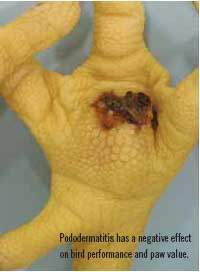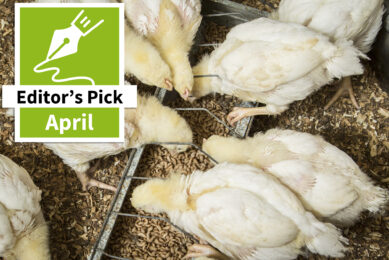Foot pad dermatitis is characterised by erosive lesions of the foot pad. It begins as contact dermatitis, which can lead to ulceration of the skin at the hock joint and the plantar surface of the feet. Lesions usually start as a thickening of the reticular scales, causing cracks that expand to broad ulcers. In extreme cases, the bird may have difficulty moving and secondary infections can occur, leading to partial condemnation of the carcass in the processing plant. Chicken paws are a highly valued consumer product in Asia. The increasing demand from Asian markets made broiler feet an important export commodity for the broiler industry in the EU and the US. The sales value of these feet, however, is significantly reduced if quality is substandard due to downgrades such as contact dermatitis (“litter burns”). Recently foot health has become a very important element in animal welfare programmes, which consequently makes it even more important to pay attention to foot pad quality.
The effect of zinc
Field reports frequently suggest that a high incidence of litter burns is also possible from flocks with good quality litter. These conditions arise, according to Auburn University professor Dr. Joe Hess, when providing high protein feeds and/or high levels of soybean meal. This possible association between an increase in Pododermatitis and all-vegetable feeds was the reason for Prof. Sergio Vieira and his Brazilian Rio Grande do Sul research fellows to take a closer look at it. He concluded from their trials that feed formulation can indeed affect litter moisture and the incidence and severity of Pododermatitis. Birds fed all-vegetable diets based exclusively on corn and soybean meal showed an increased potential to develop footpad dermatitis as well as to produce excreta with greater percentages of moisture when compared with those fed diets with inclusions of poultry by-product or corn gluten meal.
Follow-up research at Auburn and Rio Grande do Sul on behalf of Zinpro Performance Minerals showed improvements in Pododermatitis when complexed zinc was included in broiler feeds either in place of inorganic sources or when added on top of existing trace mineral premix inclusions (Figure 1). Not only the percentage of burns dropped, but zinc also dramatically reduced the severity of lesions (Figure 2). Straight run broilers fed additional zinc from Availa-Zn or iso-levels of zinc and manganese from Availa-Z/M showed that foot pad score at day 44 and day 53 were improved compared to standard sulfate supplemented fed broilers. Broilers from On Top Availa-Zn treatment had decreased foot pad lesion scores on both days. The ISO 40 Availa-Zn and On Top 40/40 Availa-Z/M treatment also numerically decreased the foot pad lesions scores.
At the 2008 International Poultry Scientific Forum in Atlanta, Georgia, US, Auburn University researcher Saenmahayak said that diet supplementation with zinc amino acid complexes increased the number of salable paws significantly and also had a positive effect on body weight and feed conversion. These findings are in-line with trial results at the PARC Institute in Easton, Maryland (Table 1). Saenmahayak did not detect differences in carcass and component yields; however, deboned fillets and total breast yields were significantly higher in zinc-treated birds.
These research findings show that dietary zinc from complexed sources improves the incidence and severity of foot pad lesions, and as a result bird performance may improve resulting in higher returns at farm as well as processing level.

 Beheer
Beheer









 WP Admin
WP Admin  Bewerk bericht
Bewerk bericht